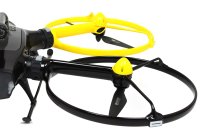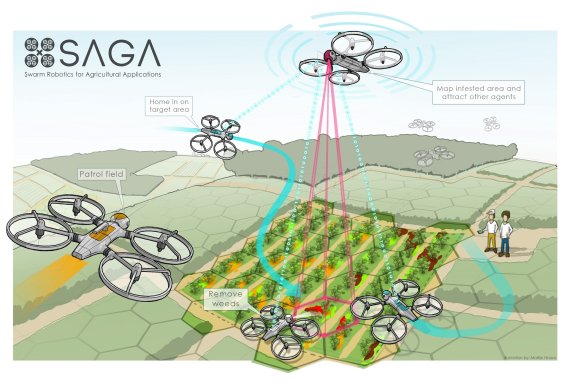Imagine a field of sugar beets. Here and there, you see a potato plant peeking through the foliage: potatoes grew on this field in the previous year. Drones are circling above the field. Their movement might seem random at first glance, but it just appears to be that way. The tiny flying robots are mapping the exact locations of the potato plants. While doing so, they busily communicate with each other. ‘Have you got one yet?’ ‘Yeah, it’s swarming with potatoes here. You better come over and help.’
EU project
This would have been science fiction ten years ago. However, it is not anymore. Swarm robotics is the next step in the agricultural application of drones, explains Joris IJsselmuiden of the Farm Technology Group. His group collaborates with Italian scientists and the Dutch company Avular; together, they are working on the next step. The project, financed by the European Union, was presented last week at a conference in Italy.

Swarm robotics will help farmers map the weeds in their fields. The project primarily focuses on biological farmers. IJsselmuiden: ‘Biological farmers are constantly occupied keeping an eye on their parcels. They often use mechanical control. Timing is of the essence: the weeds need to be smaller than the crops when you start weeding.’ Swarms of robots could relieve you of the explorative work.
Battery time
The advantages of drones are obvious. They are quick and efficient. Swarms of robots that communicate with each other could manage parcels many hundreds of acres in size. ‘You would not be able to do that with a single machine. In addition, they can take turns’, explains IJsselmuiden. ‘Drones have a limited battery time. Weed detection by drone is not one hundred percent efficient either. Detection using multiple drones would decrease the chances of mistakes.’The sugar-beet-field-with-potatoes is the model that the scientists will be working with. That is not a coincidence. ‘It is a "use case" that we have been researching for many years’, clarifies IJsselmuiden. ‘The detection technology is ready, and we even already have a weeding robot on wheels developed for this case. But we will also look into other weeds. We have already visited a biological farmer in Italy to pick up some ideas.
A next step is the optimisation of the weeding itself
Joris IJsselmuiden, agricultural robotics researcher
The drones are supplied by Avular. Wageningen is responsible for the detection of weeds using cameras and (together with the manufacturer) for the control of the drones. The Italians are responsible for the swarm-like behaviour of the robots. The principle of this is comparable with the behaviour of a swarm of foraging bees: they lead each other to locations where the most can be found. In this case weeds instead of nectar or pollen.
Science fiction
The drone swarm first needs to map the weeds and deliver an optimal planning for the weed control. ‘A next step is the optimisation of the weeding itself. This could be done from the air, with the help of drones, but could also be achieved with robots on the ground. This is where it really becomes science fiction’, IJsselmuiden looks ahead. He expects to receive the first two machines soon. The final swarm will consist of eight drones.

